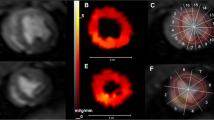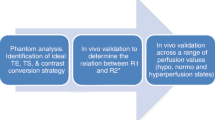Abstract
A direct comparison of extracellular and intravascular contrast agents for the assessment of myocardial perfusion was carried out in a porcine model (N = 5) with a flow-limiting occluder on the left anterior descending coronary artery. Rapid imaging during the first pass of an extracellular or intravascular contrast agent with a saturation-recovery-prepared TurboFLASH sequence showed comparable peak contrast-to-noise enhancements in myocardial tissue regions with flows averaging 1.1 ± 0.2 at baseline to 4.8 ± 0.6 ml/min/g during hyperemia. The coefficient of variation between the MR estimates of blood flow with Gadomer-17 and the microsphere blood flow measurements was 11 ± 11, while the corresponding coefficient of variation for blood flow estimates with the extracellular CA was 23 ± 11. Blood volume differences between rest and hyperemia observed with the intravascular tracer were significant (V vasc(rest) = 0.078 ± 0.013 ml/g, versus V vasc(hyperemia) = 0.102 ± 0.019 ml/g; p < 0.05). The effects of water exchange were minimized through the choice of pulse sequence parameters to provide blood volume estimates consistent with the changes expected between rest and hyperemia. This study represents the first application of multiple indicators in first pass imaging studies for the assessment of myocardial perfusion. The use of an intravascular instead of an extracellular contrast agent allows a reduction of the degrees of freedom for modeling tissue residue curves and results in improved accuracy of blood flow estimates.
Similar content being viewed by others
References
Li D, Zheng J, Bae KT, Woodard PK, Haacke EM. Contrast-enhanced magnetic resonance imaging of the coronary arteries. A review. Investigative Radiology 1998; 33: 578.
Stillman AE, Wilke N, Jerosch-Herold M. Use of an intravascular T 1 contrast agent to improve MR cine myocardial-blood pool definition in man. Journal of Magnetic Resonance Imaging 1997; 7: 765.
Wilke N, Simm C, Zhang J, Ellermann J, Ya X, et al. Contrast-enhanced first pass myocardial perfusion imaging: correlation between myocardial blood flow in dogs at rest and during hyperemia. Magnetic Resonance in Medicine 1993; 29: 485.
Manning WJ, Atkinson DJ, Grossman W, Paulin S, Edelman RR. First-pass nuclear magnetic resonance imaging studies using gadolinium-DTPA in patients with coronary artery disease. Journal of the American College of Cardiology 1991; 18: 959.
Higgins CB, Saeed M, Wendland MF. Magnetic resonance contrast media for myocardial imaging. Proceedings of Investigative Radiology 1990.
Wilke N, Kroll K, Merkle H, Wang Y, Ishibashi Y, et al. Regional myocardial blood volume and flow: First pass MR imaging with polylysine-gadolinium-DTPA. Journal of Magnetic Resonance Imaging 1995; 5: 227.
Kroll K, Wilke N, Jerosch-Herold M, Wang Y, Zhang Y, et al. Accuracy of modeling of regional myocardial flows from residue functions of an intravascular indicator. Am J Physiol (Heart Circ Physiol) 1996; 40: H1643.
Wiener EC, Brechbiel MW, Brothers H, Magin RL, Gansow OA, et al. Dendrimer-based metal chelates: A new class of magnetic resonance imaging contrast agents. Magnetic Resonance in Medicine 1994; 31: 1.
Canet E, Revel D, Forrat R, Baldy-Porcher C, de Lorgeril M, et al. Superparamagnetic iron oxide particles and positive enhancement for myocardial perfusion studies assessed by subsecond T 1-weighted MRI. Magnetic Resonance Imaging 1993; 11: 1139.
Schmiedl U, Ogan MD, Moseley ME, Brasch RC. Comparison of the contrast-enhancing properties of albumin-(Gd-DTPA) and Gd-DTPA at 2.0 T: and experimental study in rats. AJR, American Journal of Roentgenology 1986; 147: 1263.
Li D, Zheng J, Weinmann HJ, Woodard PK, Bae KT. Contrast-enhanced MRI of coronary arteries: comparison of intravascular and extravascular contrast agents. Radiology (in press).
Chung KI, Chung T-S, Weinman H-J, Lim T-H, Choi BI. Quantification of ‘no-reflow’ zone with Gadomer-17-enhanced MR imaging during ATP-induced hyperemia (abstract). First Annual Meeting of the SCMR, Society of Cardiovascular Magnetic Resonance, Atlanta, GA 1998.
Wilke N, Jerosch-Herold M, Wang Y, Huang Y, Christensen BV, et al. Myocardial perfusion reserve: assessment with multisection, quantitative, first-pass MR imaging. Radiology 1997; 204: 373.
Bassingthwaighte JB, Goresky CA. Modeling in the analysis of solute and water exchange in the microvasculature. p. 549. In: Renkin EM, Michel CC, editors. Handbook of Physiology — The Cardiovascular System. Am Physiol Soc, Bethesda, MD, 1984.
Crystal GJ, Downey HF, Bashour FA. Small vessel and total coronary blood volume during intracoronary adenosine. American Journal of Physiology 1981; 241: H194.
Tong CY, Prato FS, Wisenberg F, Lee TY, Carroll E, et al. Measurement of the extraction efficiency and distribution volume for Gd-DTPA in normal and diseased canine myocardium. Magnetic Resonance in Medicine 1993; 30: 337.
Kennan RP, Zhong J, Gore JC. Intravascular susceptibility contrast mechanism in tissues. Magnetic Resonance in Medicine 1994; 31: 9.
Majumdar S, Zoghbi SS, Gore JC. The influence of pulse sequence on the relaxation effects of superparamagnetic iron oxide contrast agents. Magnetic Resonance in Medicine 1989; 10: 289.
Donahue KM, Weissko. RM, Chesler DA, Kwong KK, Alexei A Bogdanov J, et al. Improving MR quantification of regional blood flow volume with intravascular T1 contrast agents: accuracy, precision, and water exchange. Magnetic Resonance in Medicine 1996; 36: 858.
Jerosch-Herold M, Wilke N, Stillman AE, Wilson RF. MR quantification of the myocardial perfusion reserve with a Fermi function model for constrained deconvolution. Medical Physics 1998; 25: 73.
Judd RM, Atalay MK, Rottman GA, Zerhouni EA. Effects of Myocardial Water Exchange on T 1 Enhancement during Bolus Administration of MR Contrast Agents. Magnetic Resonance in Medicine 1995; 33: 215.
Schwitter J, Saeed M, Wendland MF, Derugin N, Canet E, et al. Influence of severity of myocardial injury on distribution of macromolecules: extravascular versus intravascular gadolinium-based magnetic resonance contrast agents. Journal of the American College of Cardiology 1997; 30: 1086.
Lima JA, Judd RM, Bazille A, Schulman SP, Atalar E, et al. Regional heterogeneity of human myocardial infarcts demonstrated by contrast-enhanced MRI. Potential mechanisms. Circulation 1995; 92: 1117.
Jerosch-Herold M, Wilke N. MR first pass imaging: quantitative assessment of transmural perfusion and collateral flow. International Journal of Cardiac Imaging 1997; 13: 205.
Author information
Authors and Affiliations
Rights and permissions
About this article
Cite this article
Jerosch-Herold, M., Wilke, N., Wang, Y. et al. Direct comparison of an intravascular and an extracellular contrast agent for quantification of myocardial perfusion. Int J Cardiovasc Imaging 15, 453–464 (1999). https://doi.org/10.1023/A:1006368619112
Issue Date:
DOI: https://doi.org/10.1023/A:1006368619112




